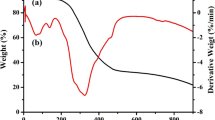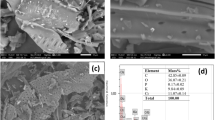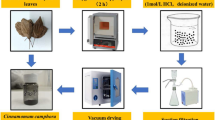Abstract
Acetaminophen (ACT) and bisphenol A (BPA) are chemical industry micropollutants adversely affecting humans and the environment. Among various biomass, Spirulina was used to prepare pristine biochar (SB400) and ZnCl2-modified biochar (ZnSB400). The performance of different Spirulina-based adsorbents in terms of ACT and BPA adsorption was compared. The highest removal efficiency (for ACT, 67.7%; for BPA, 96.0%) was exhibited by ZnSB400 with its microporous structure (1.67 nm) and high specific surface area (235 m2 g−1). Regarding adsorption kinetics, the pseudo-second-order model was the best-fitting model (R2 > 0.98), whereas for the adsorption isotherm, the Redlich–Peterson model provided the best fit (R2 > 0.99). The efficiency in adsorbing ACT tended to decrease with temperature; in contrast, BPA did not exhibit significant changes in adsorption with temperature. The Brunauer–Emmett–Teller method and X-ray photoelectron spectroscopy results confirmed that the primary mechanisms driving the adsorption of ACT and BPA on ZnSB400 were pore filling and π–π interactions. Hence, ZnCl2-modified Spirulina biochar is a promising adsorbent capable of effectively removing both ACT and BPA from water.







Similar content being viewed by others
Data availability
The data that support the findings of this study are available from the corresponding author upon reasonable request.
References
Blanchard G, Maunaye M, Martin G (1984) Removal of heavy metals from waters by means of natural zeolites. Water Res 18:1501–1507
Choi YK, Choi TR, Gurav R, Bhatia SK, Park YL, Kim HJ, Kan E, Yang YH (2020) Adsorption behavior of tetracycline onto Spirulina sp. (microalgae)-derived biochars produced at different temperatures. Sci Total Environ 710:136282
Choi YK, Kan E (2019) Effects of pyrolysis temperature on the physicochemical properties of alfalfa-derived biochar for the adsorption of bisphenol A and sulfamethoxazole in water. Chemosphere 218:741–748
Chu J-H, Kang J-K, Park S-J, Lee C-G (2021a) Enhanced sonocatalytic degradation of bisphenol A with a magnetically recoverable biochar composite using rice husk and rice bran as substrate. J Environ Chem Eng 9:105284
Chu JH, Kang JK, Park SJ, Lee CG (2021b) Bisphenol A degradation using waste antivirus copper film with enhanced sono-Fenton-like catalytic oxidation. Chemosphere 276:130218
dos Reis GS, Guy M, Mathieu M, Jebrane M, Lima EC, Thyrel M, Dotto GL, Larsson SH (2022) A comparative study of chemical treatment by MgCl2, ZnSO4, ZnCl2, and KOH on physicochemical properties and acetaminophen adsorption performance of biobased porous materials from tree bark residues. Colloids Surf A 642:128626
El Nemr A, Aboughaly RM, El Sikaily A, Masoud MS, Ramadan MS, Ragab S (2021) Microporous-activated carbons of type I adsorption isotherm derived from sugarcane bagasse impregnated with zinc chloride. Carbon Lett 32:229–249
Eltaweil AS, Ali Mohamed H, Abd El-Monaem EM, El-Subruiti GM (2020) Mesoporous magnetic biochar composite for enhanced adsorption of malachite green dye: Characterization, adsorption kinetics, thermodynamics and isotherms. Adv Powder Technol 31:1253–1263
Fan S, Wang Y, Wang Z, Tang J, Tang J, Li X (2017) Removal of methylene blue from aqueous solution by sewage sludge-derived biochar: Adsorption kinetics, equilibrium, thermodynamics and mechanism. J Environ Chem Eng 5:601–611
Freundlich H (1907) Über die Adsorption in Lösungen. Z Phys Chem 57:385–470
Guo N, Lv X, Yang Q, Xu X, Song H (2021) Effective removal of hexavalent chromium from aqueous solution by ZnCl2 modified biochar: Effects and response sequence of the functional groups. J Mol Liq 334:116149
Guo T, Tian W, Wang Y (2022) Effect of pore structure on CO2 adsorption performance for ZnCl2/FeCl3/H2O(g) co-activated walnut shell-based biochar. Atmosphere 13:1110
Gupta M, Gupta H, Kharat DS (2018) Adsorption of Cu(II) by low cost adsorbents and the cost analysis. Environ Technol Innov 10:91–101
Hamidi M, Mohammadi A, Mashhadi H, Mahmoudnia F (2023) Evaluation of effective environmental parameters on lipid, protein and beta-carotene production in Spirulina platensis microalga. Results Eng 18:101102
Heo J, Yoon Y, Lee G, Kim Y, Han J, Park CM (2019) Enhanced adsorption of bisphenol A and sulfamethoxazole by a novel magnetic CuZnFe2O4-biochar composite. Bioresour Technol 281:179–187
Jain M, Khan SA, Sahoo A, Dubey P, Pant KK, Ziora ZM, Blaskovich MAT (2022) Statistical evaluation of cow-dung derived activated biochar for phenol adsorption: Adsorption isotherms, kinetics, and thermodynamic studies. Bioresour Technol 352:127030
Jin H, Capareda S, Chang Z, Gao J, Xu Y, Zhang J (2014) Biochar pyrolytically produced from municipal solid wastes for aqueous As(V) removal: adsorption property and its improvement with KOH activation. Bioresour Technol 169:622–629
Joshi S, Shrestha RG, Pradhananga RR, Ariga K, Shrestha LK (2021) High surface area nanoporous activated carbons materials from Areca catechu nut with excellent iodine and methylene blue adsorption. J Carbon Res 8:2
Khanzada NK, Farid MU, Kharraz JA, Choi J, Tang CY, Nghiem LD, Jang A, An AK (2020) Removal of organic micropollutants using advanced membrane-based water and wastewater treatment: A review. J Membr Sci 598:117672
Lagergren SK (1898) About the theory of so-called adsorption of soluble substances. Svensk Vetenskapsakad Handingarl 24:1–39
Langmuir I (1916) The constitution and fundamental properties of solids and liquids. Part I. Solids. J Am Chem Soc 38 (11):2221–2295
Lazarotto JS, Schnorr C, Georgin J, Franco DSP, Netto MS, Piccilli DGA, Silva LFO, Rhoden CRB, Dotto GL (2022) Microporous activated carbon from the fruits of the invasive species Hovenia dulcis to remove the herbicide atrazine from waters. J Mol Liq 364:120014
Lee XJ, Ong HC, Ooi J, Yu KL, Tham TC, Chen WH, Ok YS (2022) Engineered macroalgal and microalgal adsorbents: Synthesis routes and adsorptive performance on hazardous water contaminants. J Hazard Mater 423:126921
Li H, Yang Z, Lu S, Su L, Wang C, Huang J, Zhou J, Tang J, Huang M (2021) Nano-porous bimetallic CuCo-MOF-74 with coordinatively unsaturated metal sites for peroxymonosulfate activation to eliminate organic pollutants: Performance and mechanism. Chemosphere 273:129643
Liu Q, Jiang S, Su X, Zhang X, Cao W, Xu Y (2021) Role of the biochar modified with ZnCl2 and FeCl3 on the electrochemical degradation of nitrobenzene. Chemosphere 275:129966
Luo Y, Zeng L, Zhao Y, Zhao Z, Wei M, Jiang B, Fan J, Li D (2022a) Roles of ZnCl2 and FeCl3 in preparing high performance corn stover-based carbon materials for efficient removal of Cr (VI) from wastewater. J Water Process Eng 47:102743
Luo Z, Yao B, Yang X, Wang L, Xu Z, Yan X, Tian L, Zhou H, Zhou Y (2022b) Novel insights into the adsorption of organic contaminants by biochar: A review. Chemosphere 287:132113
Ma Y, Chen S, Qi Y, Yang L, Wu L, He L, Li P, Qi X, Gao F, Ding Y, Zhang Z (2022) An efficient, green and sustainable potassium hydroxide activated magnetic corn cob biochar for imidacloprid removal. Chemosphere 291:132707
Ma Y, Li M, Li P, Yang L, Wu L, Gao F, Qi X, Zhang Z (2021) Hydrothermal synthesis of magnetic sludge biochar for tetracycline and ciprofloxacin adsorptive removal. Bioresour Technol 319:124199
Minaei S, ZoroufchiBenis K, McPhedran KN, Soltan J (2023) Evaluation of a ZnCl2-modified biochar derived from activated sludge biomass for adsorption of sulfamethoxazole. Chem Eng Res Des 190:407–420
Moon S, Lee Y-J, Choi M-Y, Lee C-G, Park S-J (2023a) Adsorption of heavy metals and bisphenol A from wastewater using Spirulina sp.-based biochar as an effective adsorbent: a preliminary study. J Appl Phycol 35:2257–2269
Moon S, Ryu J, Hwang J, Lee CG (2023b) Efficient removal of dyes from aqueous solutions using short-length bimodal mesoporous carbon adsorbents. Chemosphere 313:137448
Natarajan R, Banerjee K, Kumar PS, Somanna T, Tannani D, Arvind V, Raj RI, Vo DN, Saikia K, Vaidyanathan VK (2021) Performance study on adsorptive removal of acetaminophen from wastewater using silica microspheres: Kinetic and isotherm studies. Chemosphere 272:129896
Nghiem LD, Vogel D, Khan S (2008) Characterising humic acid fouling of nanofiltration membranes using bisphenol A as a molecular indicator. Water Res 42:4049–4058
Nguyen TB, Truong QM, Chen CW, Doong RA, Chen WH, Dong CD (2022) Mesoporous and adsorption behavior of algal biochar prepared via sequential hydrothermal carbonization and ZnCl2 activation. Bioresour Technol 346:126351
Ninh PTT, Ngoc Tuyen LT, Dat ND, Nguyen ML, Dong NT, Chao HP, Tran HN (2023) Two-stage preparation of highly mesoporous carbon for super-adsorption of paracetamol and tetracycline in water: Important contribution of pore filling and π-π interaction. Environ Res 218:114927
Pap S, Shearer L, Gibb SW (2023) Effective removal of metformin from water using an iron-biochar composite: Mechanistic studies and performance optimisation. J Environ Chem Eng 11:110360
Paredes-Laverde M, Salamanca M, Diaz-Corrales JD, Flórez E, Silva-Agredo J, Torres-Palma RA (2021) Understanding the removal of an anionic dye in textile wastewaters by adsorption on ZnCl2 activated carbons from rice and coffee husk wastes: A combined experimental and theoretical study. J Environ Chem Eng 9:105685
Phuong Tran TC, Nguyen TP, Nguyen Nguyen TT, Thao Tran TN, Hang Nguyen TA, Tran QB, Nguyen XC (2021) Enhancement of phosphate adsorption by chemically modified biochars derived from Mimosa pigra invasive plant. Case Stud Chem Environ Eng 4:100117
Qiu B, Tao X, Wang H, Li W, Ding X, Chu H (2021) Biochar as a low-cost adsorbent for aqueous heavy metal removal: A review. J Anal Appl Pyrolysis 155:105081
Redlich O, Peterson DL (1959) A useful adsorption isotherm. J Phys Chem 63:1024–1024
Rubio-Govea R, Orona-Návar C, Lugo-Bueno SF, Hernández N, Mahlknecht J, García-García A, Ornelas-Soto N (2020) Bi2O3/rGO/MonO3n-1 all-solid-state ternary Z-scheme for visible-light driven photocatalytic degradation of bisphenol A and acetaminophen in groundwater. J Environ Chem Eng 8:104170
Sayadi MH, Rashki O, Shahri E (2019) Application of modified Spirulina platensis and Chlorella vulgaris powder on the adsorption of heavy metals from aqueous solutions. J Env Chem Eng 7:103169
Shearer L, Pap S, Gibb SW (2022) Removal of pharmaceuticals from wastewater: A review of adsorptive approaches, modelling and mechanisms for metformin and macrolides. J Env Chem Eng 10:108106
Shi W, Wang H, Yan J, Shan L, Quan G, Pan X, Cui L (2022) Wheat straw derived biochar with hierarchically porous structure for bisphenol A removal: Preparation, characterization, and adsorption properties. Separat Purif Technol 289:120796
Shin J, Kwak J, Kim S, Son C, Lee Y-G, Baek S, Park Y, Chae K-J, Yang E, Chon K (2022) Facilitated physisorption of ibuprofen on waste coffee residue biochars through simultaneous magnetization and activation in groundwater and lake water: Adsorption mechanisms and reusability. J Environ Chem Eng 10:107914
Shrestha L, Thapa M, Shrestha R, Maji S, Pradhananga R, Ariga K (2019) Rice husk-derived high surface area nanoporous carbon materials with excellent iodine and methylene blue adsorption properties. J Carbon Res 5:10
Singh S, Anil AG, Naik TSSK, U B, Khasnabis S, Nath B, Kumar V, Subramanian S, Singh J, Ramamurthy PC (2022) Mechanism and kinetics of Cr(VI) adsorption on biochar derived from Citrobacter freundii under different pyrolysis temperatures. J Water Process Eng 47:102723
Sumalinog DAG, Capareda SC, de Luna MDG (2018) Evaluation of the effectiveness and mechanisms of acetaminophen and methylene blue dye adsorption on activated biochar derived from municipal solid wastes. J Environ Manage 210:255–262
Tijani JO, Fatoba OO, Babajide OO, Petrik LF (2015) Pharmaceuticals, endocrine disruptors, personal care products, nanomaterials and perfluorinated pollutants: a review. Env Chem Lett 14:27–49
Tran HN, Lima EC, Juang R-S, Bollinger J-C, Chao H-P (2021) Thermodynamic parameters of liquid–phase adsorption process calculated from different equilibrium constants related to adsorption isotherms: A comparison study. J Environ Chem Eng 9:106674
Tran TCP, Nguyen TP, Nguyen XC, Nguyen XH, Nguyen TAH, Nguyen TTN, Vo TYB, Nguyen THG, Nguyen TTH, Vo TDH, Senthil Kumar P, Um MJ, Nguyen DD (2022) Adsorptive removal of phosphate from aqueous solutions using low-cost modified biochar-packed column: Effect of operational parameters and kinetic study. Chemosphere 309:136628
van Veenhuyzen B, Tichapondwa S, Horstmann C, Chirwa E, Brink HG (2021) High capacity Pb(II) adsorption characteristics onto raw- and chemically activated waste activated sludge. J Hazard Mater 416:125943
Wang H, Lou X, Hu Q, Sun T (2021) Adsorption of antibiotics from water by using Chinese herbal medicine residues derived biochar: preparation and properties studies. J Molec Liquids 325:114967
Weber WJ Jr, Morris JC (1963) Kinetics of adsorption on carbon from solution. J Sanit Eng Div 89:31–59
Wu H, Niu X, Yang J, Wang C, Lu M (2016) Retentions of bisphenol A and norfloxacin by three different ultrafiltration membranes in regard to drinking water treatment. Chem Eng J 294:410–416
Xing X, Zhang Y, Zhou G, Zhang Y, Yue J, Wang X, Yang Z, Chen J, Wang Q, Zhang J (2023) Mechanisms of polystyrene nanoplastics adsorption onto activated carbon modified by ZnCl2. Sci Total Environ 876:162763
Xu L, Wu C, Chai C, Cao S, Bai X, Ma K, Jin X, Shi X, Jin P (2022) Adsorption of micropollutants from wastewater using iron and nitrogen co-doped biochar: Performance, kinetics and mechanism studies. J Hazard Mater 424:127606
Yan L, Liu Y, Zhang Y, Liu S, Wang C, Chen W, Liu C, Chen Z, Zhang Y (2020) ZnCl2 modified biochar derived from aerobic granular sludge for developed microporosity and enhanced adsorption to tetracycline. Bioresour Technol 297:122381
Yang H, Joo J, Hong E, Park S-J, Lee J, Lee C-G (2023) Chicken litter-derived catalyst for persulfate activation to remove acetaminophen: An organic-waste-to-wealth strategy. Chem Eng J 471:144368
Yang X, Zhu W, Song Y, Zhuang H, Tang H (2021a) Removal of cationic dye BR46 by biochar prepared from Chrysanthemum morifolium Ramat straw: a study on adsorption equilibrium, kinetics and isotherm. J Mol Liq 340:116617
Yang Z, Hou J, Wu J, Miao L (2021b) The effect of carbonization temperature on the capacity and mechanisms of Pb(II) adsorption by microalgae residue-derived biochar. Ecotoxicol Environ Saf 225:112750
Yu Y, An Q, Jin L, Luo N, Li Z, Jiang J (2020) Unraveling sorption of Cr(VI) from aqueous solution by FeCl3 and ZnCl2-modified corn stalks biochar: Implicit mechanism and application. Bioresour Technol 297:122466
Zhang B, Liu F, Nie C, Hou Y, Tong M (2022) Photocatalytic degradation of paracetamol and bisphenol A by chitosan supported covalent organic framework thin film with visible light irradiation. J Hazard Mater 435:128966
Zhang L, Chen L, Wang J, Chen Y, Gao X, Zhang Z, Liu T (2015) Attached cultivation for improving the biomass productivity of Spirulina platensis. Bioresour Technol 181:136–142
Zhang Y, Shen B, Sajjad Ahmad M, Zhou W, Khalid RR, Ibrahim M, Bokhari A (2023) A three-dimensional active biochar for sintering in steel industry and remove methylene blue by synergistic activation of H3PO4 and ZnCl2. Fuel 336:127079
ZoroufchiBenis K, Sokhansanj A, Norberto J, McPhedran KN, Soltan J (2022) A binary oxide-biochar composite for adsorption of arsenic from aqueous solutions: Combined microwave pyrolysis and electrochemical modification. Chem Eng J 446:137024
Funding
This work was supported by the Korea Forest Service (Korea Forestry Promotion Institute) through the R&D Program for Forest Science Technology (Project No. 2023483D10-2325-AA01).
Author information
Authors and Affiliations
Contributions
All authors contributed to the study conception and design. Material preparation, data collection and analysis were performed by Soeun Moon and Youn-Jun Lee. The first draft of the manuscript was written by Soeun Moon and all authors commented on previous versions of the manuscript. All authors read and approved the final manuscript.
Corresponding authors
Ethics declarations
Competing interests
The authors declare that they have no known competing financial interests or personal relationships that could have appeared to influence the work reported in this paper.
Additional information
Publisher's Note
Springer Nature remains neutral with regard to jurisdictional claims in published maps and institutional affiliations.
Supplementary Information
Below is the link to the electronic supplementary material.
Rights and permissions
Springer Nature or its licensor (e.g. a society or other partner) holds exclusive rights to this article under a publishing agreement with the author(s) or other rightsholder(s); author self-archiving of the accepted manuscript version of this article is solely governed by the terms of such publishing agreement and applicable law.
About this article
Cite this article
Moon, S., Lee, YJ., Park, SJ. et al. Enhanced removal of micropollutants from water using ZnCl2-modified Spirulina sp.-based biochar. J Appl Phycol 36, 167–179 (2024). https://doi.org/10.1007/s10811-023-03122-9
Received:
Revised:
Accepted:
Published:
Issue Date:
DOI: https://doi.org/10.1007/s10811-023-03122-9




